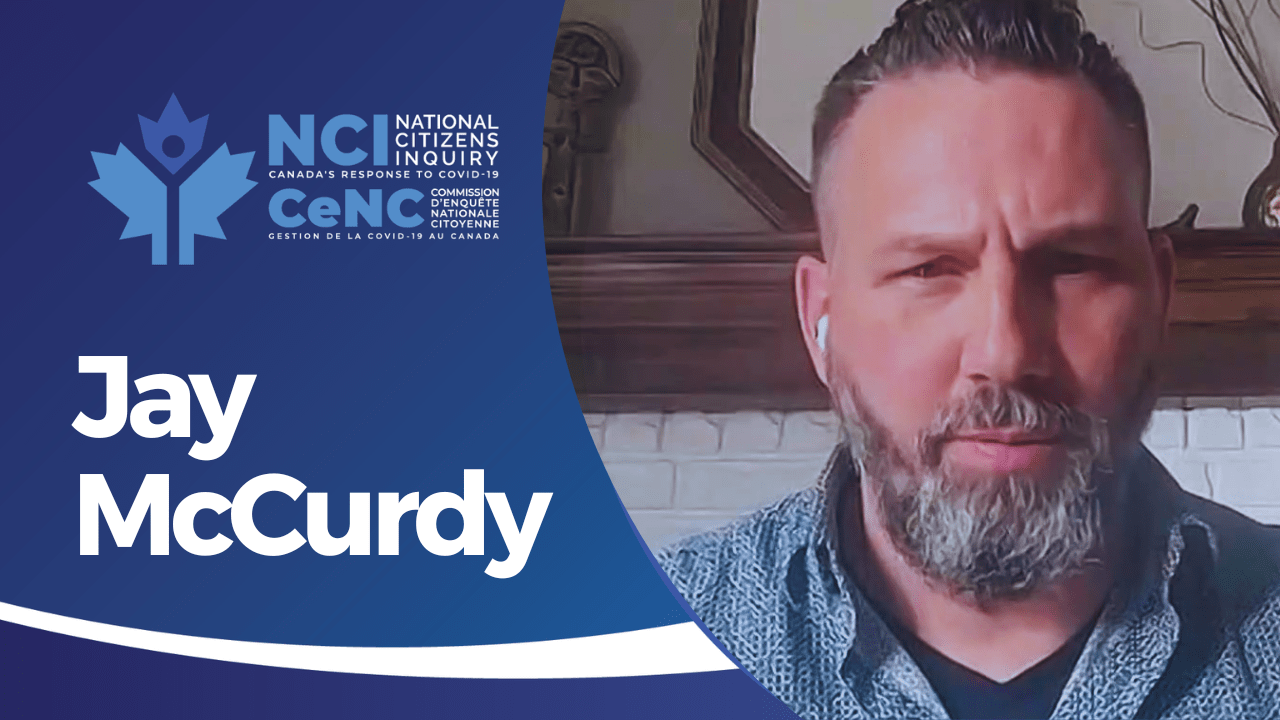Jay McCurdy is a teacher with 24 years experience in education. He addresses the impacts on children of COVID restrictions, the quality of education, and the aftermath. Students are far behind where they should be and not acquiring the knowledge at the same rate they used to.
View / Listen: Rumble|Apple Podcasts|Spotify|Google Podcasts|Podbean
[00:00:00]
Allan Rouben
Mr. Jay McCurdy, I believe, is going to be appearing virtually.
Jay McCurdy
Hi there.
Allan Rouben
Mr. McCurdy, how are you?
Jay McCurdy
Good, how are you, Allan?
Allan Rouben
Very good. So tell us a little bit about yourself. How old are you, what do you do, what’s your educational background?
Jay McCurdy
I am an elementary school teacher completing my 24th year in education based in London, Ontario at the Thames Valley District School Board. Forty-eight years old. Third generation educator. Grandmother was a kindergarten teacher; mother was a high school English teacher for 30 years. Brother’s a teacher, so it’s kind of a family trade, if you will.
Allan Rouben
And what grades do you teach?
Jay McCurdy
I teach grades 7 and 8 predominantly. Outside of one year of 24, I taught high school. I trained for high school with my intermediate senior qualifications but ended up landing in a grade eight position and I haven’t turned back since.
Allan Rouben
And in a nutshell, what’s the subject matter you want to talk about today?
Jay McCurdy
Well, you know, in large part with this whole inquiry and the whole COVID conversation—and I appreciate every aspect of it and I agree with 95 to 99 per cent of all of the testimony that I’ve seen and in large part, all the conversations that are dissenting conversations—I just really feel like something’s missing from the conversation, and that’s a child-centered conversation.
It’s egregious to me that we’re— Even myself at times, I feel like I’m being selfish in talking about how has COVID has affected me, how has COVID has affected my parents, who are close to 80. Nobody is emphasizing the children. And it’s— To me, it’s egregious that we’re not having a conversation about the impacts on children. Children are the future, they’re the primary resource. If we don’t have children then I don’t think we have a future as a country, as a nation, as a planet.
And I would like to emphasize that portion of the conversation: How important children are to the future. And it’s just mind-blowing to me. I mean, my career has been spent— I mean, I love children. I have a son and a stepson and, watching them go through COVID, there’s a level of selfishness to this that really bothers me in terms of the adults having the conversation about themselves. And I guess I’m being extremely selfish. If I sound holier than thou that some people are not talking about the children, then forgive me, but I’m very passionate about this.
Allan Rouben
I think you’re referring to the impacts on children from the steps that were taken with respect to schools.
Jay McCurdy
Yes. The schools primarily, I can speak as a sort of frontline worker on the ground. But also, just the greater impacts of the COVID restrictions: the lockdowns, for example, and then the aftermath of COVID, violence in schools and such.
Allan Rouben
And stopping extracurricular activities and social interactions—correct?
Jay McCurdy
Oh, a hundred per cent. A thousand per cent. I’m heavily researched on this. I mean, when I come across an article or come across any sort of literature on this, it perpetuates and sort of validates everything I’ve been experiencing. My observations, my understandings of the impacts, the negative impacts on children. And I live it day-to-day as a teacher; I see those as corroborated with umpteen articles, research evidence, and so forth, right?
So I have sort of two perspectives: sort of a top-down one and a sort of an on-the-ground, face-first.
Allan Rouben
All right. And so in your specific school board, we know the lockdowns started in March of 2020. Give us a little bit of the chronology there in terms of what was happening.
Jay McCurdy
Well, the lockdowns started in March of 2020; I think it was March break. And the Ford government sent us out for the duration of the school year. So we had a— You know, that was when COVID first hit and everybody was sort of wondering what the level of severity of the threat was. And understandably so. We got sent online. And there was a whole thing with that, how difficult that is in terms of logistics.
[00:05:00]
But that happened in the spring of 2020. And there’s all sorts of challenges with that. Some of the literature, if I can just reference, I’ve got a few pieces. I don’t have screen-sharing capability but I would like to share a few items that corroborate. As I said, it’s what I perceived as the challenges of remote teaching at the time.
As I was sitting in front of a computer trying to remotely teach for the first time, it was a new skill set that we were being asked to administer. This first document here, I’ll just hold it up quickly, is the Science Table. It was the advisory panel that Doug Ford had sponsored, published on June 4th of 2021. I guess this would be reflective of the challenges of remote learning. So there’s a passage here. And ironically, the Science Table if you’re familiar, did recommend— Ontario was one of the highest; in terms of jurisdictions, the province of Ontario was locked down four times in total. More than I believe, any jurisdiction in the world. So this is where it becomes a problem for Ontario-centric conversations. And that’s why I’ve experienced such impacts from this.
I’ll just read quickly from the Science Table Advisory Panel, comprised of many researchers and such. Impact on educators:
These policy changes had direct and indirect effect on students’ classroom context and their teachers. In general, the strongest in-school influence on teachers’ learning is their teacher. Teacher effectiveness is deeply shaped by the context in which they work. COVID-19 has radically disrupted these contexts with considerable impacts on teachers’ work, as well as their own health and wellbeing. Teachers have needed to dramatically change how they teach with limited time or specific training. They’re supporting students, many of whom themselves are under exceptional stress. Furthermore, they assume responsibilities associated with ensuring safety in their school under conditions that were considered by many to be unsafe.
This is not a teacher— I’m not trying to, but this is sounding like a teacher-centric conversation. I’ll just jump to my other passage quickly here:
As well as learning to teach remotely, all teachers had to shift much of their teaching to a virtual environment, at least during the worst periods of the pandemic. This meant having to acquire or increase their own digital proficiency, which ranged from mastering technical tools to developing pedagogy, such as managing group work, assessments online. It also meant developing digital proficiency with learning among their students and trying to cultivate capacities for self-education, self-determination among these learners, so they could work independently at home while their teachers were working with other students, or while teachers, students themselves were working on asynchronous tasks.
That comes from the RSC Children and Schools During COVID-19 and Beyond: Engagement and Connection Through Opportunity publication 2021. So yeah, that was the challenges.
Allan Rouben
All right, that was from the teacher’s perspective as to the challenges that were faced by the teachers. Let’s look at the—
Jay McCurdy
Yeah. And I’m going to leave that quickly. I just want to say: that was a very disruptive thing. For the government to pretend that online remote learning was effective—the efficiency and effectiveness of that was awful.
And so that’s the beginning of it: pretending that it was okay.
Allan Rouben
All right and so we were talking about the spring of 2020. Just give us the overview from spring of 2020 until today, let’s say. What time period were the children actually in school for that, let’s say, three-year period?
Jay McCurdy
So we were off for the remainder of the school year in 2020. In the school year 2021, we had a delayed entry in the fall. We did come in, I think, in late September. We were off twice that year in the school year. We had a delayed Christmas break. So we were in school with strict COVID measures for the fall, heading up to the Christmas break. And then they extended the Christmas break, if you will. I have my stats here. I mean, in total, I can tell you that Ontario students were out for 28 weeks, which is an incredible number. We had a four-week extension after the Christmas break—that would be in 2021. And then later that year, they delayed the spring break, the March break. We had a large break until April. I don’t know the exact date, but they delayed the March break until April.
[00:10:00]
And we were off again for the balance of that year.
And then the fourth and final lockdown came in the following school year. So 2021/22, they extended the Christmas break by, I think it was eight days. So in total—over the span of COVID, spring ’20, and two school years subsequent to that—you’re looking at 28 weeks of remote learning. And that’s remote learning, you know the challenges of that. And then I can also speak to what I call pandemic teaching, which is at school.
So 28 weeks in Ontario, the damage from that remote learning is— I mean, the stories that came from colleagues, the challenges with remote learning, the impact on families trying to manage their children at home. As a teacher myself, with a son who was in grade six, seven, eight at the time, and trying to help him with his work. Again, I coped. I’m competent, I coped. But families that were disadvantaged: the literature says that in large part, the communities with low access to internet, low-income communities, had virtually no experience with online. I mean, it’s egregious to think that everyone is sitting here with internet connection and access to computers and laptops, and in a large portion of the inner-city schools, Toronto and so forth, it was virtually non-existent.
So again, to pretend that remote learning was at all—
And again, I’m just going to jump ahead for a second here. Later on I was hoping to talk about Sweden, for example: school age children were not locked down at all, not once. There were different approaches with this around the world. North America, Canada specifically and the United States, it seemed like the Western approach was a bit over the top. And if you look back over to Sweden: Sweden recently had a commission that reflected on the formalization of the government lockdowns in Western countries versus Sweden. Sweden’s was more informal: Mask if you want to mask, distance if you want to distance, don’t go to work if you’re sick versus the mandated directions from our governments. They didn’t close schools down in Sweden. It did not happen at elementary schools.
So you have very extreme in Ontario versus at the other end of the spectrum in Sweden. And if we look at the data— The commission from Sweden, I’ll hold this up right here [Exhibit TO-9b]: “Sweden’s no-lockdown COVID strategy was broadly correct, commission suggests.” So they reflected on whether their approach was okay or not. And essentially, they’re saying it was just fine. I mean, the stats on their deaths originally—they didn’t lock down—might be a bit higher. But if we talk about even the stats after the fact—we can talk about excess deaths and that whole conversation—are really low in Sweden. So there’s a whole other conversation there.
This other research paper here, the International Journal of Educational Research talks about learning loss. No learning loss in Sweden during the pandemic versus the literature that talks about the learning loss because of the lockdown in Ontario. So there’s sort of two ends of the spectrum. And I mean, we can argue where that perfect, that sweet spot would have been for locking down the children and not locking them down and so forth.
Allan Rouben
Well, let’s get to the learning consequences insofar as the remote learning was concerned and the closing of schools. So tell us, from your personal perspective, what were you seeing with your students?
Jay McCurdy
A large proportion of disengagement. For example, as a grade eight teacher, I would have close to 30 students in my class. And I saw a participation rate of 50 per cent maximum, even stooping to—
Allan Rouben
Sorry, when you say participation rate, are you talking about showing up or participating in the events in the classroom, remotely?
Jay McCurdy
Well, both, I suppose. Showing up means, you know, if you have a Meet like we’re having right now, a Google Meet where I’m instructing, you might have 50 to 60 per cent in terms of showing up for attendance in that class. In terms of submitting assignments, if I had posted an assignment, you’re down to a third, somewhere in the third range, 30 per cent that would hand in something.
There was a difference in 2020. There was a messaging that the children found out about that it didn’t matter. The direction from the Board is that—and this is problematic for this to get out maybe into the public—assessments didn’t matter. The philosophy was do no harm. For example, if students didn’t participate, didn’t submit their assignments, their marks could not go down. They caught wind of this. Students were choosing to go outside and play instead of doing schoolwork and knew their marks wouldn’t go down.
[00:15:00]
So when that messaging got out, participation in 2020 was low. Later in the pandemic, when we understood that we might be going back online and doing remote learning, assessments evaluation would count a little bit higher. But in 2021—I spoke to the spring and the summer—participation rates were still 50 [per cent], maximum 50 in terms of handing assignments in. And sorry, at that time the messaging was, “Assignments will count towards your mark and your mark can go down.” So very low participation rate overall for all sorts of reasons I can imagine.
Allan Rouben
And what about the actual learning from the fact that this was being done remotely? How did that impact on it from your perspective?
Jay McCurdy
The quality of learning was atrocious, I can imagine. The importance of in-school learning is— I mean, the data suggests how important it is, how important the teacher is, how important social interaction is at school. It’s pretty much, it’s everything. It’s critical: extracurricular activities, the socialization of children.
I was talking to a colleague the other day. We had a reflection on this. If an adult—university- or college-age students are taking online courses— I took online courses to further my education. We have learned to be learners through the school system leading up to a point. The social interaction that children receive from school, you can’t underscore how important it is. It’s critical. It’s fundamental. It’s how they learn to interact socially.
The outcome of this I see on a daily basis, in terms of what was taken away, the opportunities. Imagine 28 weeks. We’re talking about 28 weeks removed with remote learning. What about pandemic learning when the students were forced to, in the school year 2021, distance during the whole year? It was distancing their desks apart. They were in cohorts on the schoolyard where they couldn’t play with their friends. You would have two classes, for example, partnered up on our schoolyard. And this is a large schoolyard. Some schools, I can imagine, have zero capacity for this; I’m not sure how they managed this restriction. Two classrooms would partner up and play on one part of the yard and two other classrooms would partner up and play on the other part of the yard and they could not interact. It was a strict rule that students— So imagine your best friend is in cohort B and you’re in cohort A and you can’t walk over across a line to go talk to your best friend, who’s been cohort-ed and they’ve been segregated from you. Just little things like that. I mean, the psychological damage. And some of the students being far too young to understand, “Why can’t I go talk to my friend?”
Inside the classroom. you’ve got limits on how you can teach during the pandemic, what you can use as materials. I can’t run science experiments. Computers had to be covered with cellophane and wiped down with spray after use. In gym class you could only play the games where the kids were distanced apart. They couldn’t actually come in contact. I could go on all day long with just those. Like I said, as a teacher, you’re experiencing the children: how they were being asked to learn, the conditions of which were atrocious for learning. Wearing masks the whole time. It’s a whole other thing, right? It’s sometimes arbitrary.
I can tell you a quick story about masking. Masking was enforced incredibly for the two school years— 2021 and 2022, was enforced strictly for three quarters of that time. It was in the spring of 2022 where the students could, we could de-mask and the regulations were lessened. I’d often see staff members yell at students for not having their mask on, “Get your mask on.” Masks would slip down so they’re constantly being told, “Get your mask up.” During the eating time, of course, masks can come off and they can eat, but they can’t talk. If they were talking, they would get yelled at by the supervisor. You can’t talk. You’re either eating or you’re talking. If you’re talking, your mask is on.
That’s, for almost two years, a hard thing for a little kid to navigate, you can imagine. Stressful for the teachers to feel like they had to enforce that the whole time. And those are just sort of minor things, but very major things. The outcome of that, I feel, has been deeply felt by the students and their age of development. Not understanding what was going on, why, and being so fearful the whole time. As we all know right now, the case fatality rate for children is incredibly low. They were never at risk. I think after two years in the pandemic, there were 20 Canadians under the age of 20 that had died from COVID. To this day, it’s under a hundred and some of those cases,
[00:20:00]
we know, were “died with COVID” and “died from COVID.” Whatever that means, anyway.
Allan Rouben
So as you’re seeing the students coming up now into your grades, what are you observing in terms of their skill levels, their learning levels? Are they where you would expect them to be for that grade level?
Jay McCurdy
Far behind. Far behind where they’re supposed to be. And this is where, in my 24 years of teaching, if you were running an experiment, if you were controlling variables— I’ve only taught grade seven and eight for 23 years, so for 23 years I’ve taught this age group. If you’re running a controlled experiment, I can speak to: What are the differences you see, and are they causal or correlational or coincidence? This is where I would say the anecdotal data backed up with the research says that the lag in the skill sets is there—in terms of academic lags, of course.
We’re trying to catch young children up with just learning how to read and write at a basic level. At an intermediate level, where I’m at, it’s learning skills in large part, what I’m seeing. I’m seeing a lack of resiliency, problem-solving, coping, levels of confidence. Their ability to, if I were to give them a mundane task, persist with it and work through it. The learning skills lag and deficit is immense. I struggle with it every day; I’m looking to still give accommodations. The help that I have to give to children, the extra help that I have to give to them to move through a given task, the extra time that I have to give to them, and just their ability.
I’m just finishing up a unit on— For example, right now we’re doing angles; we’re doing angle relationships. I teach, let’s say it’s a two-week unit on that. And then I’m pretty old-school, I give a quiz. And the acquisition of the information, the knowledge, how to learn would be— I mean, it’s just a certain sort of expectation that I have versus— I teach for two weeks and I administer a quiz and it’s just not there. They’re not acquiring the knowledge at the same rate. They’re struggling. Even with test-taking there’s anxiety, massive amounts of anxiety with test-taking—so many things that I’m seeing in terms of that.
And then on a social level, you can imagine, the violence is up in schools. That was another aspect I was going to speak to: their ability to relate to each other or the lack thereof will equate to conflicts, of course. And as a teacher, there’s all sorts of fights going on in the schoolyards every year. Kids are kids and that’s how they learn too; they learn through conflicts, right? So it’s important to know how, if you got into a fight, why you got into a fight. You learn from that. You learn what mistakes you made as an individual, how to reconcile that. And make up and move on, sort of thing.
I’m seeing a higher prevalence of interactions that come from nowhere. A basketball game on the yard breaks into a fight. I teach grade eight, straight grade eight this year. And I tell my boys— I’m a basketball coach, we actually had a very successful season. We won our West region with first place gold medal, so very proud of that. But on the yard when they’re playing ball, the slightest things turn into a conflict or a fight. I’m just constantly dealing with that. And I say, pre-COVID, that instance of two boys posturing one another after a basket is made wouldn’t have turned into a perhaps a fight or something like that. On a grander scale, especially in the Toronto board, they’re dealing with high levels of extreme violence in the school board.
Anyway, I’ll stop there, Allan, and let you continue.
Allan Rouben
In terms of the learning deficits, what in your view is the primary reason for that?
Jay McCurdy
Without a doubt, just all of the closures of schools. I can speak to Ontario. Like I said, 28 weeks of remote learning comparative to three years in the pandemic. Collectively, I’m looking at everything compressed into three years of the education system being affected and altered as deeply as it was.
The evidence is in front of my face every day. And I talk to colleagues and they’re talking about the problems at school that we’re seeing and everything. And my response is, “Well, what do you think is going to happen if you enact these measures? We’re living through this for the first time. So you can either correlate this—you can say there’s a causal connection, that the students are suffering and lagging and violence is up because of COVID—or, no, it’s some other variables at play here.”
[00:25:00]
I think it’s clearer than clear. I mean, to me it’s clear: the disruption in the system and the disruption of learning and the disruption of social gatherings and the normal life that children were expecting to experience. You don’t have to be a rocket scientist. You don’t have to be a research scientist to see that, of course this disruption in their social lives, primarily even in their academic life, was incredibly damaging.
My son had his 13th birthday turning into a teenager. What was the gatherings? You couldn’t gather at that point. I mean, you’re having a special birthday for my son and it’s a COVID birthday. It’s no one; he can’t have a birthday party. And that’s fine, he had lots of birthday parties leading up to that. But imagine the young children: their first birthday party, their fifth birthday party, how important that is.
Watching the little kindergartners around the school. We had an assembly yesterday. We’re having assemblies for the first time in the last year, where the school gathers in one area. I was up in front of the school presenting. And down in front, you have the young kindergartners and they don’t have their masks on and they’re looking up all bright-eyed and wonderful and they’re just so happy to be there. And it’s just amazing. That experience was stripped from them for two full years, pretty much. How can you argue that wouldn’t be problematic or detrimental to their growth and development? It’s pretty clear, actually.
Allan Rouben
You were obviously concerned about this as it was going on. What about your colleagues? What was the talk within the teacher community as opposed to the administrators? What was the feeling amongst the teachers so far as you’re concerned?
Jay McCurdy
I would suggest that it was sort of— I mean, we’re kind of like frontline workers. I don’t know if there was on a day-to-day basis much reflection, it was just “get through the day.” It was a lot of stress. COVID teaching was very stressful, especially in the school year 2021 and even the fall of 2021, the next school year. Getting through the day was just like a triage. It was just, “Get through the school day; we all know just how challenging it is to teach under COVID conditions and restrictions and limitations in the school setting.”
What you’re used to being able to do versus what you’re being coerced to do—just such a challenge. I mean, we were all thinking it. We were all living it. I don’t think there was much discussion. It’s not even close in terms of equating it to healthcare, what it would have been like to work in a hospital, during the heavy waves perhaps, where the stress level on the nurses and such and the system is collapsing because there isn’t enough staff, right?
And another thing that happened, basically, was that during COVID, the stress levels of teachers went up and a lot of teachers retired early. They went up on stress leaves and such. So we were living it and we weren’t discussing it too much, but it’s almost like you wink and nod to your colleague and say, “Here’s another COVID day.” We have a board in our office where there’s an absentee board. And you can walk in on any given day and see which staff are off and who’s filling in for them. Something that became sort of very patterned during COVID is that the board would be full. It would be long, full, and you would have multiple staff off during any given day because of various reasons. Maybe they had COVID, maybe they were sick, but other parts where stress leaves were high. It was basically triage in the school system for a better part of two years.
And we’re just coming out of that now. In terms of, like, the system not collapsing. And this is just one school and one school board. I’m in London: I can’t imagine what it was like in other jurisdictions like Toronto. There were just two references here in my papers that I wanted to find quickly in that regard too. There’s one reference quickly in terms of, I call it the “system damage.: This is, again—this is coming again from the Science Table COVID-19 Advisory Panel. By the way, this was something the Ford government had their hands on prior to the final and fourth lockdown in 2022.
And in this document, they were advising the Ford government not to lock us down for the fourth time. This panel, this paper basically was the proof in the pudding that we should avoid lockdowns at all costs with children. And we’ve already had three. But he disregarded that and locked us down for the fourth time.
So back to the system damage, this is from page eight in that paper. This would be probably, I think, an elementary perspective, where there is a higher proportion of female teachers.
A highly feminized workforce, educators as a group were particularly affected by carrying responsibilities for their own children at home while continuing to work.
[00:30:00]
A national survey suggests that teachers have experienced considerable stress and burnout during COVID-19. There are further reports of teacher shortages resulting from leaves and attrition from the profession in light of COVID-19 context. As a result of these shortages, exceptional measures, such as allowing student teachers temporarily teaching certificates and, in some cases, hiring non-teachers were undertaken. There may be long-term effects on the profession in terms of the teacher supply.
And I’ve got a quick story for you. One other reference very quickly from an article in the National Post, author Paul Bennett, speaking to violence in schools, February 27th, 2023. I’m just going into the fourth page. I admit this is U.S. perspective: “Amid fears of a national U.S. teachers’ shortage, the National Education Association now claims that half of all American teachers have reported considering or actively planning to quit because of deteriorating school climate and safety.” It says, “So far, this has not reached that crisis point in Canada’s systems.” But I would argue that it has.
One quick story. I think it was a couple of months ago, I had a supply teacher come in. And this is how bad it is right now. Teachers’ colleges are now a two-year program. They’re pulling teacher candidates from the programs, either first or second year, and employing them as supply teachers. And even worse than that, we’ve got— I know in Toronto, my brother teaches in Toronto, and it happens to be that they have pre-teachers’ college candidates. So you’ve got someone just in an undergrad degree, let’s say third or fourth year with an undergrad. I don’t know who comes in the room and I don’t know who asks the question, “Would you like to go teach in a school, tomorrow?” And so this wonderful young lady came in and gave it her best, but had no business being in front of the kids that day. You can imagine. Just— They’re trying to close the gaps there. Healthcare is even worse. Teaching is right behind, probably.
Allan Rouben
Sounds like it’s a vicious circle.
Jay McCurdy
Absolutely.
Allan Rouben
What are some of the other system impacts that you’re seeing and have observed?
Jay McCurdy
System impacts: the two just are the resources, like I had mentioned, just maintaining the school’s integrity, the school system integrity with having enough quality staff and teachers in front of the children. That’s still very prevalent and pervasive. The only other—well, the other system damage, like I spoke of, was the violence in schools where the stress on the system right now is difficult.
Administrators are really struggling to balance the proceedings of their school in terms of administering education every day. And it’s managing the building with just the prevalence of misbehavior. In an elementary school, we might not use the word— I mean, we can use the word “violence,” but we’re talking about children having temper tantrums and throwing chairs. And there are staff getting hit with chairs; there is staff getting hit with items. And some of these special needs’ scenarios are sort of extreme but administrators are having a heck of a time trying to sort of navigate and mitigate the outcome in terms of how the children are coming out of COVID.
I just think that the system damage is that there’s just pressure to keep the school healthy, the school systems healthy, so that learning can happen. I mean learning is critical. And learning is being compromised right now with the collective stress of the children and the collective stress of the adults combined with, sort of this misbehavior. It is just making teaching and learning challenging on a day-to-day basis. And it’s very challenging. Like I said, I’m very experienced at my job and I’m seeing younger teachers not equipped to cope with this. And younger and younger administrators not equipped to cope with managing it as well in terms of the higher level of misbehavior and violence in the schools.
Allan Rouben
Have you heard of or been party to any discussions from officials in the Ministry of Education where there is some sort of recognition or acknowledgment that locking down the schools, closing them down and moving to remote learning, was a problem—was something that shouldn’t have been done? Is there any sort of talk like that?
Jay McCurdy
Yeah, we’re not seeing anything. I’m not seeing anything from our jurisdiction in Ontario on a board level or provincial level. The only thing I was able to— I was curious myself about this, was from the United States. There’s an article here I can show from the Wall Street Journal. It’s from the union.
[00:35:00]
It’s written from the Wall Street Journal. Author, sorry—
Allan Rouben
Right. I’ve given that to the commissioners. One of them is an editorial in the Wall Street Journal from November 2nd, 2022 [Exhibit TO-9a]. And I’ll just read the opening sentence. “Believe it or not, American Federation of Teachers Chief Randy Weingarten, on Monday, tacitly acknowledged that keeping schools closed during the pandemic was a mistake. Miracles happen apparently.”
But what is being mentioned here is that Ms. Weingarten and her colleagues, and needless to say, the same is true in Canada: they were the ones who were pushing for this with the greatest enthusiasm from day one, right?
Jay McCurdy
From the union perspective— There’s a whole another can of worms there, where they’re trying to protect their members. I would imagine many teachers wanting the schools closed down permanently, just in fear of COVID.
Some of the research says that in large part, COVID wasn’t transmitted in schools, it was transmitted through community. Meaning that children who picked up COVID got it from their homes. They didn’t get it at school. So the union perspective, the union approach in terms of their messaging would have been, “Let’s protect our members. And the best way to protect our members is to not be at school at all.”
But now, that article you referenced there, I have that article. Sorry— There was another article referenced in The Atlantic by Emily Oster. Oster cites school closures as one example. “There’s an emerging, if not universal, consensus that schools in the U.S. were closed for too long. The health risks in school spread were relatively low, whereas the cost to students’ well-being and educational progress were high.” That’s pretty much the snapshot right there.
Allan Rouben
It seems to me that the thinking that went into this is quite similar to the thinking that went into COVID policies generally, which was: there wasn’t any real assessment of the costs versus the benefits. Is that a fair statement?
Jay McCurdy
That’s absolutely my mantra. My mantra has been cost–benefit analysis from day one. The cost–benefit analysis in terms of the perspective of the child. In the context of learning, they spend a lot of time at school, so it’s important that that experience is on the table for them, but just generally on a societal level as well.
The cost that we ask students to do through the pandemic: like I said, case fatality rate, COVID infection rate was low with children. It has been proven that they lack the ACE2 receptor in the nasal cavities for COVID to even sort of stick. And when they got sick, they didn’t get that sick at all. In fact, post-COVID, the RSV [respiratory syncytial virus], that respiratory illness— I mean, my anecdotal evidence says it took down a lot of kids with a lot more severity than COVID did during COVID.
But yeah, like, in terms of the greater societal level, the damage is there over that time. Cost–benefit: it’s just unbelievable what we asked the kids to do. And what we took from them. From a child’s perspective, you should be working as a society to protect your children. I mean, we should think about that, right?
One evidence piece I wanted to reference here that speaks to that. There was— Some of you Commissioners might be familiar with the Great Barrington Declaration, co-authored by three significant doctors. One of them, Dr. Jay Bhattacharya, was a professor at Stanford. He’s got a PhD in economics and focuses on health economics. I watched a podcast with him recently where he referenced a— Not sure if he was an author, a researcher, last name Christakis, in a pediatric journal. This is citing data: “From the spring 2020 closure, it is estimated that 5.5 million life years have been taken from children.”
From that particular time frame is a very staggering stat: you’re taking life years away from children. My father, who’s 79 years old, had a stroke about six months ago. My father lived a long, full life. It’s tragic when anyone’s life ends and it’s sad. But you know, he’s now 79. And Pops has lived a long, amazing life.
[00:40:00]
And it’s difficult watching him in the aftermath of his stroke. But, you know, he’s lived his life. These children haven’t lived their lives yet. It’s just mind-blowing to me what we’ve done, the damage that we’ve potentially done.
Without that calculation, Allan, what you said about that cost–benefit? In my opinion there was zero cost–benefit done. Absolutely none.
Allan Rouben
What’s really troubling about this, it seems to me, is that the children can’t advocate for themselves. Collectively, adults are the decision makers. And it’s hard not to reach the conclusion that we’ve failed our younger generation here. What do you say?
Jay McCurdy
I think we’ve failed them in every way possible. I can’t imagine failing them any more than we have. I don’t know. It sounds very pessimistic and extremist to say this, but we have a struggle in front of us right now. I’m not making this up, I’m watching it. I’m just wondering what that long-term impact’s going to be. Longitudinal studies and such that are going to be able to even correlate this and say, “How are we going to be able to look back in 10 or 20 years in terms of economic activity in the GDP and say it was because of COVID?”
Of course, this is happening. There would be no admission of that anyway. It’s going to be blamed on other variables and factors 10, 20 years down the road. But I just really have a gut suspicion. I have lots of papers sitting around me right now that are studies and professionals that say this is going to be a problem. Very smart people that are acknowledging it as opposed to not acknowledging it. I think that’s important, that if we could—
My takeaway with this is not make this mistake again. We might be paying a large price for this down the road. It’s inevitable. It’s going to come at us and we’ll just have to manage it.
But we better not do this again the same way. There needs to be a cost–benefit analysis at the very least and a conversation where all stakeholders are allowed into the conversation. It’s not just the government dictating. It’s everyone having a voice. And that’s why I really appreciated being able to testify here: It’s giving the average citizen that voice. There are a lot of us that are highly intelligent that are in this room today that have a lot of perspectives and a lot of stories. We don’t need to do [inaudible] research papers to understand this has been impactful in a negative way across all sectors, across the economy.
I have a friend who lost his job from COVID. I have watched small businesses close during COVID. You don’t have to look at papers to see it. You just look out on your front stoop and look outside and see the damage in your neighbourhood, your community.
Allan Rouben
There were some personal perspectives that you wanted to share. Is there anything else that you wanted to say on that? Tell us about the impacts of— You talked about the impacts of remote learning but what about the masking when the kids were even in the classroom? What do you see as the impact of that?
Jay McCurdy
Well, the masking was a symbol of fear, so there’s a psychological impact. We sort of sent this message, “We’re going to go to school and we’re going to wear masks. And be careful, if you catch COVID, it’s very dangerous. Something can happen to you.” When the data came in—like I said, in 2020—and then a lot of the research, medical research scientists started collecting the data and the hospital data came in, it became evident that COVID wasn’t directly a threat to children.
But the masking at schools when it’s a room full of children: if I’m not sick, if I’m not symptomatic—and this whole nonsense about carrying COVID asymptomatically, I don’t buy it—if you’re not symptomatic, I’m pretty sure you’re not going to get it. But that’s my personal perspective. But the symbolism of the masking was pervasive because of, I think, the fear. Children are like, “Why are we wearing masks? What’s going on here?” It’s just— Outside of trying to teach with the masks on. Listening to children talk and trying to teach with a mask on and the limited sort of sonic experience, we’ll call it, was challenging. But when masks came down, I watched staff actually berate children: “Get your mask back up!” Right? That’s a whole other component. But the damage of the masks, I don’t know. It was a symbol of fear.
[00:45:00]
Here’s sort of an anecdotal observation. After the mask restrictions were lifted, children still continued to wear masks, in large part, in the school setting. Still fearful of— I can imagine their parents may have said, “you need to wear a mask,” but a lot of children chose to wear one. Higher grade students—grade 7, 8—were still wearing them for some time. I was of the mantra, “It’s time to take them off. It’s time to breathe. It’s time to see your face. It’s important. So take them off, take them off.” I mean, I wasn’t pushing it, I was just sort of advocating for it and sending subtle messages that it was important.
I’ll just read a quick excerpt from this article, it’s from the American Institute of Economic Research. I’ve got page 5 of 11, just a quote about masking that I sort of highlighted:
Concerns are being raised regarding psychological damage and why a mask is not just a mask. There’s tremendous psychological damage to infants and children with potential catastrophic impacts on the cognitive development of children. This is even more critical in relation to children with special needs: those within the autism spectrum who need to be able to recognize facial expressions as part of their ongoing development. The accumulating evidence also suggests that prolonged mask use in children or adults can cause harms, so much so that Dr. Blalock states, ‘the bottom line is that, if you are not sick, you should not wear a mask.’ Furthermore, Dr. Blalock writes, ‘by wearing a mask, the exhaled viruses…’
Okay, we won’t get into that part.
But the psychological damage: I have a stepson who has special needs, diagnosed with autism disorder, who basically stopped going to school because of mask-wearing. He was unable to attend school and wear a mask. It wasn’t possible for him to do that; he couldn’t wear a mask. It’s a sensory issue, it’s, you know. So school was taken away from him because of a mask and that’s factual.
Allan Rouben
I wonder if there’s any questions from the panel.
Commissioner Massie
Thank you, thank you very much for your testimony. I have two questions. First one is: In your experience as a frontline teacher, can we get out of all of the damage that was done on the kids unless the institution is willing to admit that this was wrong? How can you convince kids that wearing masks is not “no longer necessary,” but was never necessary in the first place? Is that something that you think is possible within our current school system?
Jay McCurdy
I think it involves conversations. I think it involves information and there’s a lot of information flying around. You know, information can come from studies like this. Information can come from various sources. It’s a conversation, an acknowledgement of— maybe going back to the cost–benefit, I’m not sure. Like Allan had mentioned, the adults that are in charge have an obligation. The students themselves are going to take a lead on the adults. So it’s a reflection. It’s a cost–benefit that needs to be reflected upon and in the future needs to be done.
For example, in the future, if something comes along: Remember what masking did to children before. De we really want to do it again? We can’t go back in time and change what happened. But one of my things moving forward is ensuring that these sorts of things don’t happen again unless they’re absolutely necessary and we can prove it. And not—it’s just messaging, it’s like a top-down, “Thou shalt mask.”
My information tells me that even in jurisdictions like Sweden, masking was optional. Just let citizens decide to wear a mask. People can wear a mask if they want to wear a mask but, you know, the forcefulness of it is damaging, right? So just a reflection, just an honest reflection and conversation. There’s lots of studies out there that say masking is ineffective. So let’s just grab onto those studies and perpetuate the information as not disinformation, but actual studies. So just keep studies. Be open, be mindful to competing studies and be open and mindful to the conversation. That authoritarian sort of approach is not really a pleasant approach at the end of the day.
Commissioner Massie
My other question is: I think I heard you say that the damage, if you wanted the learning, was probably more profound for students that had more difficulty of learning or because they could not access as readily good internet or other technology or support from family or community. So these children are probably more at risk to suffer the long-term consequences of the lockdowns and all of the measures.
[00:50:00]
So is there a plan that is put in place right now by the institution in order to address this need that was created by the lockdowns and all of the measures that probably affected even more this population of students that have issues with learning?
Jay McCurdy
Well, because we’re in a crisis of funding— I think, in large part, money can solve a lot of problems. If you have the resources. Human resources have to be in place I guess, first. And right now, there’s a lack of human resources, right? There’s decline in the— People are leaving the profession, teachers are leaving. So are we going to be able to replace the workforce? Right now, it’s not looking so good. Like I said, we’re bringing in the university students that may or may not even become teachers and throwing them in the classroom to basically, perhaps try their best, but in large part maybe babysit for the day.
My wife actually works with special needs. She’s an educational assistant, and they’re highly trained professionals who have different sorts of degrees. They can have PSW [patterns of strengths and weaknesses], they can have child psychology, for example. There’re all sorts of different educational sort of skill sets they bring, and highly trained and skilled professionals.
So my wife for example works with high-needs children. And so with being off a few times and watching the replacements that are coming in: they call them “paid volunteers,” which doesn’t make sense. I know they’re volunteering, but they’re getting paid. Our board has brought in basically, people off the street that want to make some money and work with children that—you know, may provide a background criminal check and maybe they love children and want to help out. And that’s fine. But these workers are coming in and they’re replacing the professionals who have the credentials and experience and education with zero credentials, experience, and education. And have no business working with those children. It basically becomes a babysitting role.
And it becomes a safety issue. Because in large part the training of an educational assistant deals with high behavior and mitigating damage when special needs children are having, let’s say, you know, a bad day. So the damage can be confounded when you have people that don’t know what they’re doing trying to manage a situation that’s problematic. And now you have two problems on hand, right? Instead of one.
So I don’t see the human resources right now. I’m not sure how we— With the baby boomers, we can get into a demographic conversation about our aging population. But I’m not sure we’re going to be able to find the human resources in terms of education and even health care and other sectors. I’m not sure. Look outside in the community, all the help wanted, all the unemployment signs. Help here, help everywhere, right? So it’s not being fulfilled. And then from a money standpoint, I mean, you can—
Allan Rouben
Let me stop you, Mr. McCurdy, because I think we’re running out of time and some of the other commissioners might have some questions. So if you don’t mind, let’s get to those.
Jay McCurdy
Not a problem.
Commissioner Drysdale
Good morning, Mr. McCurdy. Thank you for coming and appearing before us. I have a few questions and some of them are related to testimony we heard from previous witnesses. We heard testimony from witnesses that were attacked. There was one yesterday who was shopping in Walmart, and she reported how she was attacked and people stood by. There was one in Truro, where a gentleman went into a Canadian Tire and was attacked.
I wonder: You talk about fear in the children. To my mind, these attacks—these reactions by people, including our officials and police, were due to what I would call “terror.” You talked about fear in the children but, in my mind, there’s a difference between fear and terror.
And the adults were experiencing terror in the way they acted towards their neighbors, to their families. But adults have certain capacities and certain experiences that would allow them to hopefully temper those emotions. So what levels of terror or fear did you see in these children who did not have the capacity to temper that?
Jay McCurdy
Well, that’s a very interesting observation you’ve made there. I haven’t thought of that. It sounds very valid to me. That’s certainly possible, what you said, the capacity to handle your emotions. We’ve learned, as we were all in development, how to handle our emotions and cope. So maybe you’re seeing a lag in a sort of, I don’t want to say, ability or skillset, but yeah— Reacting and having that emotional overlay of being, living in constant fear.
[00:55:00]
So perhaps you’re seeing inability to cope and that’s just playing out in real time in terms of excess incidents of violence in the school setting. Just maybe they’re exercising this and it’s just coming out—everything’s coming out right now. Whether they’re contemplating, “I’m doing something bad” or not. It could just be pure energy coming; it was contained and now the energy’s coming out. It’s not good energy.
Commissioner Drysdale
In your class or in your school or with colleagues that you have discussed, have you noticed any perceptible increase in suicide, self-harm, with the kids following the lockdowns and return to school—or during the lockdowns?
Jay McCurdy
I can’t speak to that data. On a personal level, I do see a larger proportion of what I would consider despondent children, who look like they’re struggling in terms of depression. And that translates into absenteeism rates as well. So I’m seeing a higher-than-average absenteeism rate. Children that are still sort of disengaged from school and despondent when at school. So there’s certainly a larger proportion of those children that are struggling on a day-to-day basis and struggling to be at school, to get to school. So as I said, there are some stats there that are coming out of the pandemic. They’re still certainly struggling on an emotional level. Absolutely.
Commissioner Drysdale
Were vax mandates imposed on teachers?
Jay McCurdy
Not in my jurisdiction. With Thames Valley, they were not. And I think the only jurisdiction in Ontario was Toronto, teachers were mandated.
Commissioner Drysdale
Okay. Did the administration or the government, to your knowledge, come to the teachers themselves or teacher’s organizations and review with them what they were considering as mandates prior to implementing them? In other words, did you have a say?
Jay McCurdy
Well, no. Of course, I just think that was one of my biggest concerns, was having a voice. No, it was directed. It was all top-down direction, “Thou shalt.” And a lot of pressure. I mean, there’s peer pressure. There’s also pressure from your employment, messaging from your employers about “This all needs to be followed and strictly followed” and so on and so forth. So that’s a lot of psychological pressure in and of itself, to be told, “This is how this is all going to play out.” All the restrictions, all of the COVID sort of overlays like I was talking about. The hand sanitizing, for example, and the mask wearing, the keyboard covering, the keyboard wiping down, and all those sorts of things. It’s just sort of like a memo: “This is the memo and we’re all to follow it.” From a managerial level, you’re looking at risking probably disciplinary if you walked outside of those expectations.
Commissioner Drysdale
My last question: I have two sons who are teachers and I know that on a regular basis, they go for additional training. They don’t call them this anymore but they’re in-service days and they go to take courses. Prior to 2020 pandemic, did any of the teachers receive any training with regard to potential pandemics and what should be done to reduce spread? And were you made aware of any pandemic planning that was in place prior to 2020?
Jay McCurdy
Absolutely not. That would have been virtually impossible, right? I think on many fronts. It was almost like this was all after the fact, right? The pandemic is in place and let’s figure out how we’re going to— Yeah, I mean, moving forward maybe it’s something where we should reflect on this and say, “Hey listen, next time, here’s again what we do what we don’t do.”
No, it was just thrown at teachers like: “This is what we’re doing, we’re walking into school, and we’re”—I’m spray-painting dots on the ground with a spray paint can out front of my portable so the students can stand on these dots and be two meters apart. And when they get inside the desks are supposed to be two meters apart and masks will be on. It was all just real time, figured out on the fly, which for teachers was stressful.
Yeah, you probably heard stories, considering your children are teachers. It’s like, “you need to just figure this out, teachers, and you need to just make it happen.” And I’m not a health care professional. My skill set is limited to what I have. But just enacting and following through and trying to make sure all of these requests, I will call them, were followed—was challenging in and of itself right. So very stressful, for sure.
Commissioner Drysdale
Thank you.
Commissioner Kaikkonen
Good morning. I have so many questions I’m not really sure where to begin. But the line that we hear from the school boards in Ontario is that, “Well, we’ve lost two years of learning to COVID.”
[01:00:00]
I’m just wondering: Ss a teacher, do you believe that we will ever recapture those two years of learning that these children have lost?
Jay McCurdy
My perspective and answer to that is that I don’t think it will be recovered wholly. I think there’s going to be a gap, always be a gap. I don’t know how you can close that. I think that this is why I’m so passionate. I think that the formational years of a child, let’s say they say the most important years in the life of a human is between zero and five, for example. I’m not a psychologist. I can only venture to say that the damage that was done, the COVID babies and such, I don’t think you can recover that wholly. I just— It’s my gut feeling.
From an adolescent standpoint, there was one study that I read that said that the most damage to the adolescent age group was age 15 to 18, somewhere in that range. Where the psychological damage on them was greater than other age cohorts. And you could probably make an argument that every single kid, no matter their age, experienced that. I don’t know. I mean, people can say, “Yeah, we’ll close the gaps. Everything will work out. They’ll be fine.” “Kids are resilient,” is the one I hear all the time. You know, “Kids are resilient. You know, they’ll get through it, we’ll be okay.” So you can downplay all of this and say, “They’ll be fine. It’ll all just work out in the end.” But the problem with that is that you can’t project into the future and then look back and then change it. If you find results you don’t like and agree that we messed up, you can’t go back in time and fix it. That’s the problem, is that it’s a catch 22 or something like this.
Commissioner Kaikkonen
And in terms of going forward, we have school boards at this point in Ontario who have decided that the last set of standardized tests that were given to the students will be the new bar, the new standard for education going forward. Do you see some serious issues with that mindset? That we’re just going to take the bar that comes after COVID as opposed to standardized test results that came before COVID? In terms of our long-term research into how our children are faring and how their reading and writing skills are being projected going forward?
Jay McCurdy
Well, we have to absolutely maintain the pre-COVID bar. We have to. I mean, we can’t lower the bar, we have to put it back up. And that’s what I’ve been trying to do in my classroom. I’ve slowly been— So the analogy would be like high jump or, moving into track and field season, would be to lower the bar down so that everyone can have success. But as they build their skills, because we’ve lost our practice with skill building, you’ve got to raise the bar back up slowly. What I’ve been trying to do is raise it up incrementally. But my goal is to have that bar back up to where it was before.
I mean, if I can talk 10 years from now and say, “Do I have that bar back up to where the bar was pre-COVID?” Will it be 20 years? How long will it take me to have that bar back up where it can be that high and the kids can attain success? So right now, the bar has to be lowered for all sorts of reasons, but there needs to be a concerted effort to decide that bar has to be back up to pre-COVID standards for all sorts of reasons.
Commissioner Kaikkonen
And my final question is: Do you think you’ll get an apology from Education Minister Lecce or your school board or school boards collectively or the Ministry of Education for what they have done to these children?
Jay McCurdy
Well, I don’t think there will be an apology. Of course, I don’t expect that. I would like a “thank-you” in some form. Some sort of thank-you for helping to weather the storm. I’m just one frontline worker. A thank-you to everyone for keeping up with the effort and not giving up on the children in the system. A large thank-you would be in order, I think. That would go a long way. Apology won’t happen.
Commissioner Kaikkonen
Thank you.
Allan Rouben
Mr. McCurdy, we had asked witnesses who gave evidence to swear in. So if you don’t mind, I’m just going to swear you in. So do you swear that the evidence you’ve given is the truth, the whole truth, and nothing but the truth, so help you God?
Jay McCurdy
Absolutely.
Allan Rouben
Thank you very much, and thank you for coming today.
Jay McCurdy
Thank you, Allan. And thank you for allowing me to speak. I really want to thank the Commission also and the whole Inquiry for what they’re doing. They’re giving voices to the average citizen. I think that’s critical. I think it’s imperative that the more people that can talk and we can have just a large conversation. And I guess the healing can start and we can move forward in a more productive fashion instead of being so divisive and contemptible.
So thank you very much for running this Inquiry, and thank you for allowing me to testify. I greatly appreciate it.
Allan Rouben
Thank you.
[01:05:07]
Final Review and Approval: Jodi Bruhn, August 16, 2023.
The evidence offered in this transcript is a true and faithful record of witness testimony given during the National Citizens Inquiry (NCI) hearings. The transcript was prepared by members of a team of volunteers using an “intelligent verbatim” transcription method.
For further information on the transcription process, method, and team, see the NCI website: https://nationalcitizensinquiry.ca/about-these-transcripts/
Credentials
- Teacher with 24 years experience in education
- Employed with the Ontario, Thames Valley District School Board
- Junior high teacher, father
Summary
Addresses the impacts of COVID, the restrictions and the aftermath on children. Lockdowns in his school district started in March 2020, and there were 4 in total, with Ontario students having 28 weeks of remote learning. He refers to many studies and states that during COVID-19 the efficiency and effectiveness of remote learning was “awful”. There are communities with low-income communities, so had virtually no online access for remote teaching. The philosophy of the education board was “do no harm”, so if students did not participate or submit their assignments, their marks could not go down. As a result of this any other reasons, there was very low participation rate (<50%).
When in class learning resumed, there were rules that you could not use computers, no science experiments, gym classes only could be with distanced activities, etc. The learning conditions were “atrocious”. Then they had to wear masks the whole time, except for eating. So, teachers would reprimand students when they spoke to friends at lunch time, if they forgot to put their mask back on. Mr. McCurdy states that masking is a symbol of fear. He cites to the cognitive challenges and harms psychologically to children.
In addition to education, the extra-curricular activities, and the socialization of students in school are essential. Kids must learn to interact socially, and this was hampered. Then when in 2021 the kids were forced to “distance” from other students, both in class and in the playground. There were strict rules that a child could not interact with their friends in other cohorts even when outside at recess. He feels that the children did not receive the education or social connections that they themselves expected, which was also detrimental to their growth and development.
Students are far behind where they should be and not acquiring the knowledge at the same rate they used to. There is a lack of resiliency, problem-solving, coping, levels of confidence and their ability to persist with mundane tasks. He has seen increased test taking anxiety. These issues lead to lack of understanding and compassion during social disputes, in turn leading to increased disputes and violence. There’s also a larger proportion of seemingly despondent children who look like they’re struggling in terms of depression.
The stress levels of teachers increased during the pandemic, resulting in teachers retiring early or going on stress leave. Exceptional measures, such as allowing student teachers temporary teaching certificates and, in some cases, hiring non-teachers, were undertaken. Paid volunteers are coming in without credentials, experience, or necessary education and replacing the professionals who work with students (with high needs). The problems from the restrictions and lockdowns have not been acknowledged by the board or the provincial government to his knowledge.






















